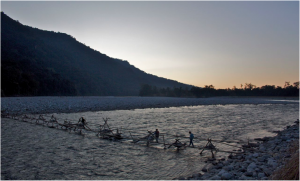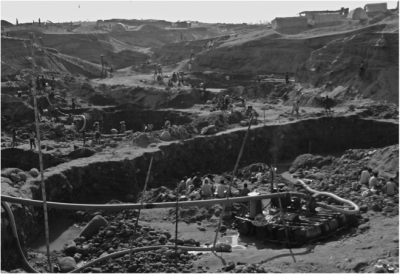3rd Letter from India
Assam
I reckoned the Rolls could fall 2 feet without breaking the springs, but not 5, which was the drop from the deck to the river bank. The gang-planks were 14 ft long, so the slope was about 1 in 3. They were 2 inches thick, which for a 2-ton motor was thin.
Jan arranged rock wedges to ease the front wheels onto the planks. A large crowd assembled to watch the spectacle. I felt like an Olympic athlete trying to break the world record for foolishness. Oliver waited expectantly behind his film-camera, Claire H with mine. The captain beckoned me towards what, from my perspective behind a long bonnet, was thin air.
Half way down I heard cracking. The captain yelled “go for it!”. Never did the Rolls move so fast. She was on the sand in a flash, racing forward until she slurped into a mud-hole. No problem there – the crowd made short work of pushing her out. There was much cheering and shouting. Celebratory chai was brought in cheap plastic cups.
The following day our 3 daughters flew in from London. We had, after much consideration, selected Mancoota, a tea-planter’s house near Dibrugah not far from the Brahmaputra in Eastern Assam, as the place to celebrate their arrival. Built in 1900, it had 2 enormous bedrooms, an exquisitely furnished drawing room, 2 studies and – the quintessential feature of a planter’s house – wide wooden verandhas.
We picked tall bunches of bouganvillea from the estate garden and arranged them in high vases on sturdy teak tables, selected the finest Assamese delicacies for our first meal together and set off to collect them in the Rolls accompanied by Rupu, our guide and friend. We spent 2 magical and important days there, drawing together the threads of our respective lives, hearing of new friends, of roads taken and not taken and new turns in their professional and academic lives.
Claire departed for the UK and Oliver for Calcutta to secure a visa for Bangladesh.
Then we laid the topographical maps on the teak tables, consulted Rupu about time and distance and road-conditions, and made a plan.
Setting out the 1st morning, just the five of us, was a magical moment. We drove between tea plantations towards distant hills, the open road unrolling before us. We remarked on the quality of the wooden wheels on the oxcarts and stopped to purchase multi-coloured folding plastic Stars of Bethlehem, the local Christmas decorations, and took lunch in front of at least a 100 passing mobile phones. This might have had something to do with the fact that the Rolls had by then featured several times on Assam prime time TV, but the focus of attention was, I noted, the children not the car. Not to be out-done, they responded in kind with the iPad. It had not previously occurred to either Jan or I to use this machine for photographs, and the moibile-owners loved it. In due course it was turned on us. For the 1st time images of the expedition could be, and were, created and distributed in a matter of seconds.
During the early days of travelling with the children – 28 years ago, when Katherine was 3 – I learned to look at the world through their eyes as if, like them, I was seeing it for the first time. I have never quite lost the habit. Overloaded trucks swerving across the road straight at you, which is perfectly normal in these parts, suddenly looked rather frightening. Piles of fruit on flat-bed carts looked more enticing and had to be bought; the crowds, when we stopped in a busy street, seemed more curious.
As of course they were. Three English girls sitting in the back of a large motor car, or drinking marsala chai perched high on spare wheels, are an altogether different proposition to Jan & I. (I have never quite recovered from Jan’s description of us, in one of her letters home, as an elderly British couple driving an elderly English car across an ancient continent). Family bonds are central to Indian society, and the sight of the five of us enjoying each others’ company on the road, or decamping into the street for a little light roti & dal fry, aroused instant curiosity. Were all of them our daughters? Were they married? Did we have any more? Or any sons? (Oliver came in useful on this count when he re-joined us). The cavalcade, it seemed, challenged the prevailing belief that family life in the West is declining like its economy, for it provoked questions about how it was that this was so.
We abandoned the Rolls 2 days later in a plastic-roofed hut near a tea-plantation and hired a 4×4 to get to a National Park in the far north-east corner of India. Few people go there, with good reason: it is along way from anywhere, the roads are bad, the bureaucracy worse and political tension is high. Namdapha lies in Arunachal Pradesh, adjacent to India’s border with Burma.
After a poor night in a dilapidated rest-house we crossed the fast-flowing Noa Dhiling on an unstable bamboo bridge and walked deep into semi-tropical rain-forest. We cooked rice and vegetables in bamboo sealed with banana leaves, Carmody and Katherine and Jan identified plants and trees.
Rose noted an almost complete absence of wildlife. The forest ranger said it was there but we just couldn’t see it. Our guide said it had all been shot by poachers from the Lisu Tribe, who lead a semi-nomadic life in the core of the park. The team from All India Radio, who we ran into by chance round a camp-fire that night, said poachers from outside were selling skins to the Chinese. As so often in India the truth is hard to find. The Radio team did, however, record my (well-developed) views about illegal – or indeed legal – logging in the area, for which there is plenty of evidence. I do not know whether the interview was broadcast.
Poachers are also a problem in Kaziranga, the better-known and much visited National Park some 200 miles away beside the Brahmaputra. The unofficial
response in Kaziranga is to poach the poachers: 100 of them have been shot in the last few years. This is about the same number of Rhinos shot by the poachers. The horns, which are made of compressed hair and have no intrinsic value at all, fetch $80K in China. The Rhinos, collectively speaking, are not bothered. They are multiplying.
So are the Royal Bengal Tigers, though rarely seen. So when we saw one, pretty close up, on Christmas day, there was much jubilation. The Day was christened Tiger Christmas and toasted in Bob & Sandy’s parting gift of Champagne. Presents were exchanged in our bedrooms in Wildgrass. The said Stars of Bethlehem were arrayed on the walls and wrapping paper strewn over the massive teak floorboards which creaked in the night.
We went to Church near Kaziranga. It was a friendly affair, but the sermon went on a bit. My father–in-law, who did not favour long sermons either, told the priest at Katherine’s christening to “buck up”, which was embarrassing for us but very effective. I decided on reflection to take a tea-break instead. In due course Carmody came to find me, and we strolled back together. As we passed the street signs she translated them for me. I remarked that I was not previously aware she could read Hindi. It was the same script, she pointed out, as Sanskrit, which is vantage number 2 of travelling with daughters: they know more than you do about almost everything.
There were of course ups and downs. Some time later we climbed high into the Megalayan Hills. Jan and Katherine were both poorly, the temperature fell and the road got worse. In fact it really wasn’t there at all. The trucks, however, were. These leviathans of the Road, emitting dense black instant-cancer-inducing fumes and shrieking high-pitched horns as they overtake on blind hair-pin bends, are mildly stressful. Although the Rolls has a powerful engine, and I have learned the art of blocking and using blockers (a necessary skill on mountain roads), by the time we arrived at the Shillong Club after 8 hours of leviathan-dodging we were all shook up, hungry, tired, cold, ill and out of sorts.
In the wonderful way of things when travelling, the turn round was miraculous. A fire was lit for us, supper on the table, hot-bags, as hot water bottles are divertingly called in these parts, were produced, and the following morning we were taken out to the very finest English breakfast in a timber-frame house on top of a hill (Pinewoods, for those who know Shillong). Our hosts, friends of friends who had been following our journey and were delightfully amazed that we had made it thus far, gave us a touching send–off. We headed downhill to Bangladesh in high spirits, for that night we were guests at a new years eve gathering of friends – including Oliver, just in from Calcutta – and sundry distinguished Bangladeshis at Lalakal, just over the border.
High spirits, but mildly worried, for the promised entry papers had not so far, I discovered before we left Shillong, been lodged with Customs. Bangladesh withdrew from the international Carnet Treaty about 2 years ago. Without these papers we had no chance.
The track, for in places it is no more than that, to the border is little travelled, steep, narrow and takes those who pass this way through an extraordinarily beautiful and surprisingly empty landscape. It drops 7000 feet, steeply at times, down to the alluvial plains of Bangladesh so that, were it not for the dust and haze which hovers over the sub-continent, you could almost scan the Bay of Bengal.
Far more arresting than that, however, is the sight of the great rock mine at Jaflong. You cannot see it until the road cuts diagonally across the escarpment in the final drop to the border, but when you do you stop and look. Here 20,000 workers dig giant boulders out of deep pits gouged out in a dry riverbed. Men and women in single file like soldier ants bear baskets of boulders from pit to truck; and in the breaking yards men with frightening torsos smite boulders with boulder-breaking hammers. The air is heavy with rock-dust, the leaves of trees a ghostly white and the shop-keepers wear masks. The thunder of rock-crushers and throaty diesel engines echo across the plains, lending an unearthly atmosphere which Dante would have relished.
Scar on the face of the earth though it appears at 1st sight, as mines go this one wins the competition for renewable resources: every year the monsoon rains sweep it spotlessly clean, and bequeath to Bangladeshi a fresh harvest of Indian rocks free of charge to build their roads. Rocks in these parts are rare as diamonds in Sussex, and though the work is tough the pay is good.
At 4 pm we said farewell to Rupu, to whom the children were devoted. Shortly after that we arrived at the border post of Tamabil, smack in the heart of Dante country.
This was not a place for old Rollses to hang about.
Rupert Grey January 2013



